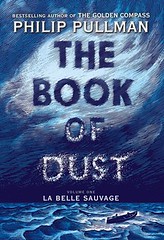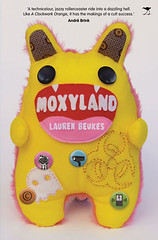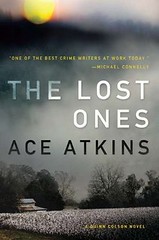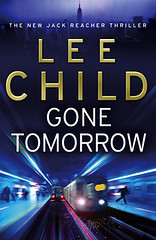Then it started to rain, so she went inside and made some coffee and did what she had never done in her life: tried the newspaper crossword. “What a stupid exercise,” said her dæmon after five minutes. “Words belong in contexts, not pegged out like biological specimens.”
— Philip Pullman, La Belle Sauvage
 La Belle Sauvage (The Book of Dust #1)
La Belle Sauvage (The Book of Dust #1)
by Philip Pullman
![]()
I devoured Philip Pullman’s “His Dark Materials” trilogy several years ago, enrapt from beginning to end. I hadn’t realized, before that experience, how rich “young adult” fiction could be. Afterward I sought out good YA fiction and science fiction, finding authors and series to love, but all this time what I’ve really been waiting for is more of the world and characters Philip Pullman invented in his original trilogy.
It’s been worth the wait. It all came back, from the first page on: dæmons, alethiometers, Gyptians, Oxford, the witches of the North … and then a reference to Lyra, then Lord Asriel, and then, chillingly, Mrs. Coulter. To my delight I realized “La Belle Sauvage” is a prequel to “The Golden Compass,” with a child protagonist as fascinating and believable as Lyra Belacqua in the earlier works (Lyra, as mentioned, is here too, this time as an infant, along with her infant dæmon Pantalaimon).
The protagonist, this time around, is the 11-year-old son of a couple who run an inn just upriver from Oxford. His name is Malcolm Polstead, and his dæmon is Asta. The adventure starts in the first chapter, when mysterious guests ask Malcolm about the priory across the river and the nuns who live there. It soon becomes known that the nuns have taken in a baby. The baby is Lyra, and sinister forces are determined to snatch her. As in the “Golden Compass” books, the sinister forces are sent forth to do their dirty work by the Magisterium, aka “The Church.” Saving Lyra from the Magisterium’s clutches falls to Malcolm, and good lord it’s a hair-raising tale.
I was literally breathless when I finished the book. How long has it been since I’ve read anything this gripping and engaging? A while, for sure. Oh yes, I read lots of thrillers, and they all have gripping plots, but I always know some bozo like me wrote the book. With Pullman, I forget about the bozo behind the book. When Malcolm’s excited, I’m excited. When he’s frightened nearly out of his wits, so am I. This is how it was when I first discovered my love of reading as a child, when a good book could sweep me off my feet. That Pullman can do that to me as an adult is … well, it’s genius, is what it is.
My understanding is that Philip Pullman actually started working on what became “La Belle Sauvage” before writing the “Golden Compass” trilogy in the early 2000s. He returned to “La Belle Sauvage” two or three years ago, and it’s meant to be the first installment of a new trilogy, “The Book of Dust.” There’s no publication date for the next two books, but in the afterword to “La Belle Sauvage” Pullman says the next one will jump ahead two decades, and feature Lyra in her 20s.
I cannot wait, but I must.
 Moxyland
Moxyland
by Lauren Beukes
![]()
Apart from initially downloading a Swedish-language version of “Moxyland” to my Nook, then having to go through the thrash of correcting my mistake with B&N, this book was a pleasure to read.
I had earlier read Beukes’ “Broken Monsters,” a police procedural with supernatural plot elements set in the American city of Detroit, and compared her favorably to the writer Mo Hayder. There’s nothing of the supernatural in “Moxyland.” Instead there is an oppressive regime against which young people resist and rebel, using technology, and I am reminded of William Gibson.
“Moxyland,” Beukes’ debut novel, is set in South Africa, Beukes’ own country. Its young characters try to survive in, work around, protest, and even topple the repressive corporate security state SA has become. Set in the near future, it’s full of fascinating (and chilling) cyber extrapolation. One example: cell phones the police can remotely “defuse” (think taser) you with, or, perhaps worse, disconnect from the grid, rendering you an unperson, unable to communicate, use transportation, make social or commercial transactions, even access your own apartment.
Some reviewers see racial apartheid in Beukes’ near-future SA, I did not. Her characters, black and white, are socially & personally connected; the repression is all-encompassing, directed at citizens of all races. The apartheid I see in “Moxyland” is between the privileged–those who live relatively cushy lives after signing on to work for life with corporations–and everyone else.
The main characters, as mentioned, are connected, but I had a hard time figuring out how and as I read on it wasn’t getting any clearer. Halfway through, I took a short break to read some reviews of “Moxyland.” In addition to clearing things up, it enhanced my enjoyment of the rest of the novel. I do not think this would have happened with a Gibson novel: he’s somewhat better at crossing Ts and dotting Is for dummy readers.
Still, a very impressive novel, and I will certainly read more by Lauren Beukes.
 Thud Ridge: F-105 Thunderchief Missions over Vietnam
Thud Ridge: F-105 Thunderchief Missions over Vietnam
by Jack Broughton
![]()
I remember reading “Thud Ridge” in 1974 as I was going through USAF pilot training, trying to get a feel for what flying fighters in combat was like, since I so badly wanted to become a fighter pilot myself. At the time, the very tail end of the air war in Vietnam, single-seat fighter pilots were the manliest men in the business, and that’s the kind of pilot we all wanted to be. A few of us made it.
Today I volunteer at an air museum. I saw a copy of “Thud Ridge” on the docent library shelf and took it home to re-read. Forty-plus years hasn’t changed my appreciation of the book much. I was a little less patient with Jack Broughton’s complaints about the restrictive rules of engagement that exposed American aircrews to needless danger, but only because he was repetitious. The complaints are entirely valid; Broughton and other warriors who spoke out against the restrictions were right, and I am not at all convinced, after a 24-year career flying single-seat fighters myself, that things have changed all that much since Vietnam.
I read the book then for its descriptions of aerial combat; these remain the most gripping parts of Broughton’s tale. Again, little has changed, and with experience I can now fully appreciate just how dead-on Broughton was. And macho? Good lord. Yankee air pirates and steely-eyed killers. If you ain’t a fighter pilot you ain’t shit. That’s what you read this book for and that’s what you get. I will never not admire anyone who flew the F-105 in combat.
At one point Broughton mentions singing “Mary Anne Burns, Queen of All the Acrobats” with other pilots in a squadron bar and I haven’t been able to get that great old song out of my head since. Excuse me while, re-energized, I go back to work on my memoir!
 Tool of War (Ship Breaker #3)
Tool of War (Ship Breaker #3)
by Paolo Bacigalupi
![]()
I’ve been waiting for a follow-on to Bacigalupi’s earlier YA novels “Ship Breaker” and “The Drowned Cities,” and it’s finally here. I devoured it in two days and wish there was more, but at least the stage is now set for a fourth installment, so I’ll be patient.
The principle characters of the earlier novels, children and teenagers of a near-future world profoundly changed by pollution and climate change, ruled by warlords and corporations which rose with the fall of nation-states, populate “Tool of War,” which is set a few years on, the children now teenagers, the teens young adults. They are survivors, now wiser in the ways of war, power, and corporate politics.
The main character in this book (also present in the earlier novels, though in smaller roles) is an augment, a human with spliced tiger and hyena genes, incubated in a tube and raised in a creche, trained in warfare and obedience. He is the Tool of the title, now breaking the chains of genetic subservience and striking out on his own, seeing himself as new kind of human, no longer a servant.
Here’s a relevant paragraph from my review of “Ship Breaker”:
“‘Ship Breaker’ is killer good: a young adult adventure set in a post-environmental disaster, post-nation/state world where powerful clans control global trade conducted by sailing ships and dirigibles, and society is divided into two classes: the very rich and the very poor. It’s a Margaret Atwood Oryx & Crake scenario on steroids, and like Atwood, Paolo Bacigalupi has rich narrative and descriptive powers: you can see the world of the shipbreakers on their oil-stained beach, you can feel the rust and sharp edges on the steel plates the breakers pry off their beached oil tankers, you can hear the hammer blows and the pop of forced rivets, you can smell the fuel oil and sweat. There’s nothing theoretical about Bacigalupi’s writing, nothing that requires page after page of dry explanation; his fictional world is immediate and gripping, fully revealed through the context of a kick-ass story, all but real.”
Here’s another relevant paragraph, from my review of “The Drowned Cities”:
“I really should list this as a banned book and beat the rush, because when the helicopter parents who have challenged ‘Lord of the Flies’ and ‘The Hunger Games’ see the darkness here, they will surely put “The Drowned Cities” on their target list.
Relevant how? Because some of what impressed me so in the earlier novels is missing or muted in this one. The lives of the young protagonists are less gritty and feral. The physical world is less threatening and immediate, though there are intriguing elements, as in the islands and arcologies of Seascape, the former Boston. The exciting feeling of reading something those who want to limit our knowledge and control our thoughts might try to ban or burn is absent as well. It’s as if Bacigalupi has damped the fire that burned in the previous novels … only a little, mind you, but it’s noticeable.
Hella good still, some of the best YA science fiction around, and I’ll be there for Ship Breaker #4.
p.s. Many of the ideas and concepts explored in the Ship Breaker series come from Bacigalupi’s masterful adult science fiction novel “The Windup Girl.” Another of his adult novels, “The Water Knife,” inspires parts of the future world revealed in “Tool of War.” Any fan of Bacigalupi’s YA fiction should read his adult fiction as well.
 The Lost Ones (Quinn Colson #2)
The Lost Ones (Quinn Colson #2)
by Ace Atkins
![]()
I’m reading Lee Child’s Jack Reacher novels in order, and now that I’m two books in with Ace Atkins’ Quinn Colson, I may as well read these in order too.
Lee Child and Ace Atkins write character-driven suspense thrillers featuring strong men with military backgrounds. Each new Lee Child novel puts Jack Reacher in a new location with new bad guys. Ace Atkins is going for something different, as far as I can tell from reading the first two Quinn Colson novels: Quinn is the sheriff of Jericho, Mississippi, and the supporting characters are people we got to know in previous novels. Quinn Colson is a little less hard-headed and a little more emotional than Jack Reacher. Otherwise the similarities in these two characters should guarantee that a fan of one will enjoy reading about the other.
I enjoyed “The Lost Ones,” particularly in that it finishes a story introduced in the first novel, a childhood memory of running away and living off the land in the forests of northern Mississippi. We learn here what really happened, and there’s significant emotional growth, not only in Quinn, but in his sister Caddy, who was rather a villain in the first novel.
Good escapist reading with plenty of action and memorable characters. I plan to stick with Quinn Colson.
 Gone Tomorrow (Jack Reacher #13)
Gone Tomorrow (Jack Reacher #13)
by Lee Child
![]()
Still plugging away at the Jack Reacher series and have now finished the 13th installment.
This one takes place in New York City, and Lee Child offers so many geographical details I was tempted to call up a street map of Manhattan on my iPad so I could trace Reacher’s wanderings around the 14th and 17th precincts and get a feel for directions and distances between the subway stations, parks, and hotels where the action takes place.
Reacher is riding the subway into the city late one night when he sees a woman fitting the profile of a suicide bomber, one who appears close to detonating herself. Which doesn’t make sense, because it’s the middle of the night and there are only five other passengers on the car. He confronts her and she kills herself with a pistol, pulling Reacher into a complex conspiracy, which, as always, he reasons out on his own and thwarts at the last bleeding minute. Yeah, Jack Reacher novels follow a formula, but they’re almost always good reads.
“Gone Tomorrow” is not the best Jack Reacher novel, but it is far above some others. Lee Child sometimes writes the novels in the first person, sometimes in the third person. This one is first person, so we’re in Reacher’s head all the way through. I think the first person novels are somewhat limited, because we never back away for a larger view of what’s going on. It’s a good thing Reacher is Sherlock Holmes smart and willing to share his thinking with the reader.
My Kindle doesn’t give page numbers, but rather indicates % read. I was past the 75% mark before Reacher had sex with the woman working the case with him, in fact the only woman he has sex with in the entire novel, and only the one time. That was notable, and now I have to read the rest to see if there’s one where he remains celibate.